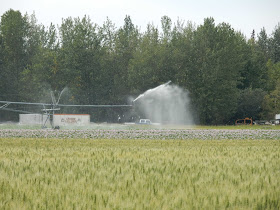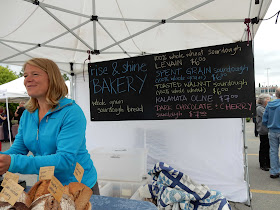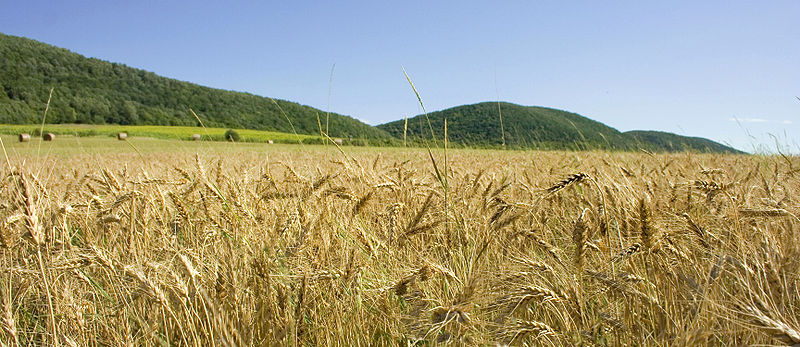VanderWeele Farm's wheat on July 21, 2015, near Palmer, Alaska with Chugach mountains in the background. The wheat was planted early this year, at the end of April, and was six weeks from harvest.
Ben Vanderweele welcomed us to his farm in the flat fertile Matanuska Valley, a 45-minute drive from downtown Anchorage. My husband, Jim, and I had arranged to meet with Ben to learn about growing wheat in SouthCentral Alaska. One reason I wanted to go was that I'd been researching and writing about wheat for twenty years and had never been to see it in the fields. Beyond that, I wanted to know why hardly anyone in Alaska was growing wheat as a cash crop, and why Ben was succeeding at it.
Ben VanderWeeele (on the right) talking to a tourist who stopped by to admire the farm, next to a truckload of cauliflower ready for market. VanderWeele Farms grows potatoes, a wide variety of vegetables, and wheat.
Eighteen-foot high Rube Goldberg contraptions sucked in potatoes from somewhere, washed them, and dumped them onto a conveyor belt set on a platform six feet above the floor for sorting and bagging. It was colder in the barn than the mid-60s weather outside, and the several college students working with the machinery dressed in warm coats.
Ben showed us a bin of potatoes, tennis-ball sized and evenly rounded, that he grows for Alaska Chip Company in Anchorage. "They like them all one size. Makes it easier for the potato chip machines."
He took us to another room where waist-high plastic cubes holding bushels of wheat sat, the grain covered with nothing more than a sheet of cardboard cut to fit. Startled, I asked about mice -- I've had mice in my garage that chewed through plastic that thick, and for things less tasty than wheat. Ben grinned and said, "The cat takes care of them." We didn't see the cat, but surmised that it must be exceedingly happy.
Each of the wheats was marked, some with numbers, others with names. Ben experiments with different varieties, looking for those that do well with the weather and soil, and are suitable for the markets that he's sought out. Last year he sent samples of five different wheat grains to the Kansas State University Wheat Quality Lab, where they analyzed the amount of protein, the water content, how well the flour ground from the grains absorbed water in a dough, and how well it worked in baking bread. LA511135 from Oregon came back the best. These were all spring hard wheats, OK for bread dough, but typically better for pastries and cakes, distilling, and other uses.
Louise wheat, flowering, about six weeks from harvest.This is a spring wheat, planted as soon as the ground can be worked, and harvested later in the same year.
Most of the this year's crop of "Louise," a soft white wheat has already been sold to an Anchorage distillery for making liquor. "Soft" wheats are lower in gluten, and better for distilling because the smaller amount of protein means a clearer drink. Wheats with higher gluten contents are better for beers because the extra gluten allows the frothy head to keep its shape for longer.
Ben said that winter wheats do poorly in Alaska. They are planted late in the summer and lie dormant in the cold, but get an early start as the snow melts. Because they can be harvested earlier in the short growing season, they might seem like logical choices for Alaska But May is chilly here so they tend to develop fungal diseases, and farmers prefer spring wheats.
Winter scene near Anchorage. Winter wheat can survive the cold, but doesn't thrive in cool Alaskan springs.
Flowering wheat stalk. The long stiff points at the end of each kernel are awns. They have little barbs, and one of their purposes is help the seed "drill" into the ground so that it can sprout.
Automatic irrigation system rolling through the potato fields about 4:00 p.m.; it will be in the wheat fields in the foreground in an hour or so.
Ben VanderWeele irrigates all of his crops, especially wheat. "The rains might be sufficient for the wheat," he says, except for the fact that they come at the wrong times. "We get twelve to fourteen inches of rain -- not very much in the spring and early summer when we need it; mostly in August and September when we'd prefer it dry." He can't do anything about the late summer rains, but he can provide water in May, June, and July when it's essential for the wheat to grow. "There's nothing easier than growing wheat, I think," he says, "but I'll never make any money doing it." Wheat, for him, is an iffier crop than many of the vegetables. "You only get one chance with wheat each season," he said. "If something goes wrong, you've lost that year."
I asked about pests. "Ten years ago we had grasshoppers," Ben said, "but we weren't growing wheat them. They were worst for the carrots that year." What about going organic? "It's a lot of trouble and expense. I never use pesticides, but I do fertilize once, at the beginning of the season. It's not what's defined as an organic fertilizer, so I don't qualify. The ground is so clean here -- no diseases in the soil and lots of nutrients. I rotate crops to keep any diseases or pests from building up. Next year, this field will be potatoes and I'll plant the wheat somewhere else."

Ben said that their land is one of the original farms developed in the mid-1930s when the Matanuska Valley Colony Depression-era farm project was started. The soil is as good now as it was then -- silt loam left by the glaciers, with very little clay. It's excellent for wheat, as well as for the root crops like potatoes and carrots on the farm. We didn't talk much about the winds, but the wheats he grows are dwarf varieties so the Matanuska winds don't matter as much.
VanderWeele wheat (and chard) for sale at the South Anchorage Farmers' Market.
Harvesting is another question. With only a few acres of grain, it doesn't make sense to have his own combine. Ben's neighbor has the right machines, so Ben uses his services. And how much grain does he harvest? Three thousand pounds per acre, he said, and added, "Maybe I could get more." That seemed to be characteristic of him -- always interested in the science and art of his crops, always wondering what he might try next.
What about the straw left at harvest? Ben said that he sells it to the Alaska State Fair to use for bedding for the show animals. Oat straw has no awns, he said, and is preferred by dog mushers and other animal owners. Wheat is next best, and barley straw is worst.
Flowers on the railing outside the VanderWeele's farmhouse. They also do well in the long, cool days.
Ben grew up on a farm in the Netherlands, and came to Alaska in 1967 with his wife Suus because there was more land here. The VanderWeeles' three kids all grew up on the farm, and still work on it; he pointed out his daughter as she drove by the barn. Twenty-five to thirty other people work on the farm as well at different seasons, planting, transplanting, weeding, harvesting, and preparing the produce for market. Of the 680 Alaskan farms, VanderWeele's is one of the most familiar in SouthCentral Alaska, one of the most successful, and one of the oldest. It is also one of the few growing wheat, and I felt fortunate to have had the chance to trace Alaskan wheat back to its roots.
Alison Arians of Rise and Shine Bakery in Anchorage at the South Anchorage Farmers' Market. All of her wheat breads use some VanderWeele's wheat.
All photos by Teri White Carns.















































